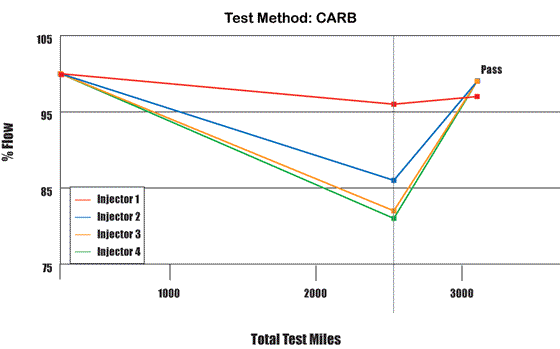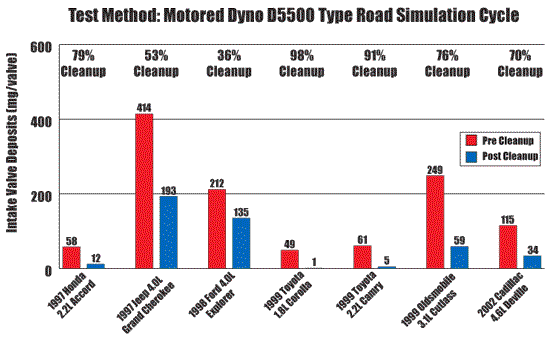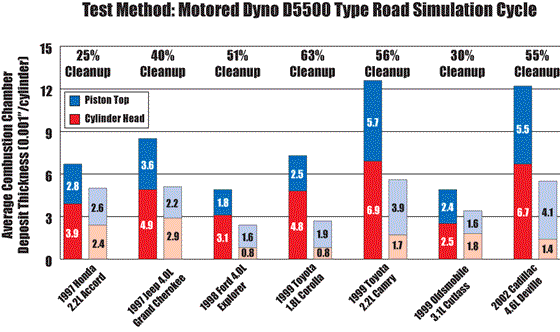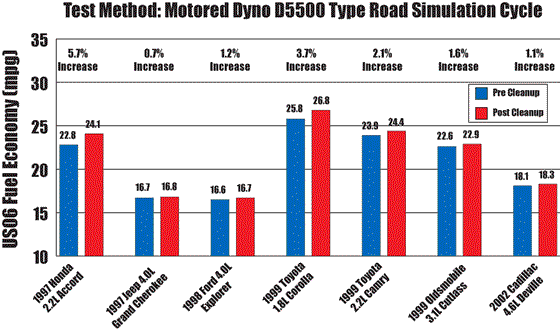|
|






































Search Our Site

|
|
|
|
P.i. Performance Improver Gasoline
Additive
|
|


Product Code: API
|
Improves fuel mileage an average of 2.3% and
up to 5.7%. Reduces emissions such as hydrocarbons (HC) up to 15%,
carbon monoxide (CO) up to 26% and nitrous oxides (NOx) up to 17%.
Restores power and performance. Reduces the need for costly higher
octane fuel. Reduces noise from carbon rap and pre-ignition. Offers
better vehicle drivability and smoother operation.
Reformulated for greater potency
Package sizes include:
|
|
|
Untreated
Fuel Leads to Poor Engine Performance
A vehicle
demonstrates its best efficiency and engine performance when it is
new. As the engine ages, its performance suffers from gasoline
fuel-generated deposits that form on the fuel injectors, intake
valves and combustion chamber. Additives are required to control
deposit formation.
Today’s fuels,
however, lack sufficient treatments of either enough additives or
high quality additives. Fuel system deposits result in the
following:
-
Lost fuel
economy
-
Lost power
and poor throttle response
-
Failed
emission tests
-
Poor
drivability - surging, hesitation, stalling, rough idle
-
Engine
knocking (pinging) and rap
-
Difficult
starts
|
|
|
Treated
Fuel Delivers Maximum Performance
AMSOIL P.i. is
the most potent gasoline additive available today. As a concentrated
detergent, it is unsurpassed in cleaning combustion chamber
deposits, intake valve deposits and port fuel injector deposits.
AMSOIL P.i. helps maintain peak engine efficiency, fuel economy,
power and drivability in newer low mileage engines. In engines with
accumulated deposits, testing showed AMSOIL P.i. provided the
following clean-up benefits after only one tank of gasoline:
-
Improves
fuel mileage an average of 2.3% and up to 5.7%
-
Reduced
emissions
-
hydrocarbons (HC) up to 15%
-
carbon
monoxide (CO) up to 26%
-
nitrous
oxides (NOx) up to 17%
-
Restored
power and performance
-
Reduced
need for costly higher octane fuel
-
Reduced
noise from carbon rap and pre-ignition
-
Better
drivability
-
Smoother
operation
AMSOIL P.i.
works as an “emissions passer.” It is ideal for use prior to
emissions inspections. |
|
|
Unsurpassed
Deposit Clean-up Port Fuel Injector Deposits form after the engine
has been shut down and there is no gasoline flowing through the
injectors. During this “hot soak” period the injectors heat up and
the gasoline remaining in the injectors degrades and forms deposits.
This can happen very quickly with the use of poor quality gasoline
and short trip driving. Because the clearances within the injectors
are extremely tight and injectors must deliver precise amounts of
“atomized” fuel, even small amounts of deposits can cause injectors
to malfunction. Fuel flow is reduced and spray patterns are
disrupted, decreasing engine efficiency, power and fuel economy,
while increasing exhaust emissions.
 |
| |
|
|
Intake
Valve Deposits
Intake Valve Deposits form
on the intake side or back side of the valves. As deposits increase,
they restrict airflow and alter airflow patterns in the cylinder.
The deposits disrupt the balanced air/fuel ratio by momentarily
absorbing and releasing fuel, and they can cause valve sticking by
getting in the way of the valve stem and guide. Deposits also
restrict proper seating, and the valves may be burned. Intake valve
deposits cause lost engine power, increased emissions, poor engine
efficiency and potential valve failure.
 |
|
|
Combustion
Chamber Deposits
Combustion
Chamber Deposits form
on the top of the pistons and on the cylinder heads. They increase
compression and absorb heat during combustion to later release it
during the intake cycle. In some engines with tight squish domes,
combustion chamber deposits cause the piston to actually hit the
cylinder head. This is referred to as combustion chamber deposit
interference or “carbon rap.” Combustion chamber deposits also flake
off as they get large, and these flakes can get trapped between the
valves and valve seat, resulting in compression loss, difficult
starting and rough idle.
Higher compression
and stored heat cause increased intake fresh charge temperatures and
the increased likelihood of pre-ignition “knock” or “pinging” when
the fuel spontaneously combusts prior to spark ignition. This
increases emissions and may cause engine damage. Many of today’s
cars have “knock” sensors that adjust spark timing to prevent knock.
Although audible
knock is controlled, power is lost from retarded timing. Higher
octane fuels of 4-5 octane numbers can be used to help prevent
knock, an effect called “octane requirement increase.” As a vehicle
ages, more expensive higher octane fuel is needed to keep it
operating at peak performance. By cleaning combustion chamber
deposits, knock is controlled, power is restored, fuel economy
increases and higher octane fuels are less necessary for peak
performance.
 |
|
|
Maximum
Fuel EconomyAMSOIL P.i. maximizes fuel efficiency by dissolving and removing
fuel system deposits and other contaminants for improved power and
overall performance.
 |
|
|
Recommendations
Treat one full
tank of gas up to 20 gallons with one bottle of P.i. For very large
gas tanks, partially fill to 40 gallons and treat with two bottles
of P.i. Using more than two bottles per treatment is not
recommended. Treat gas every 4,000 miles or 100 hours of service.
P.i. helps pass emission tests by running one tank of treated fuel
through the engine prior to testing. Safe for use with catalytic
converters, oxygen sensors, oxygenated gas and 10 percent ethanol
blended gas. Not recommended for two-cycle engines.
DANGER:
Combustible. Harmful or fatal if swallowed. Harmful if inhaled. Skin
and eye irritant. Read precautions on container before use. |
|
|
|
|

